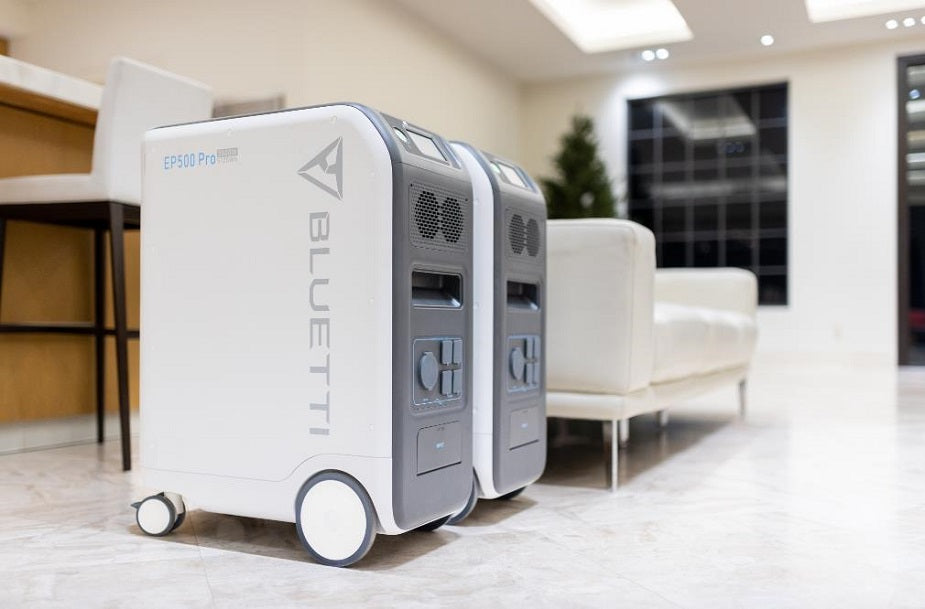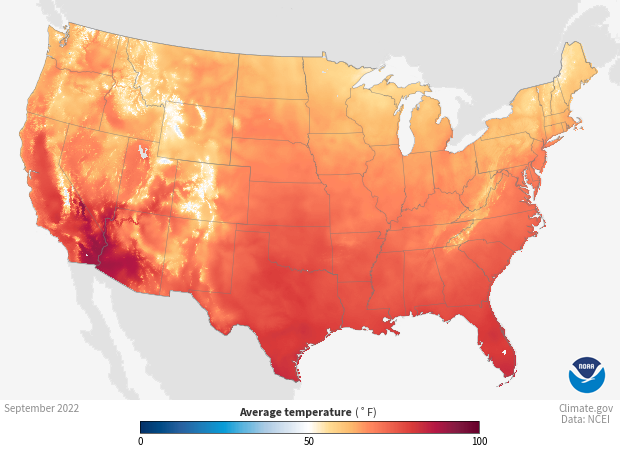
In California, from May 31 to September 16, the average daily temperature sits above 78°F, while the hottest month of the year is July. During this month you could expect temperatures with an average high of 86°F and low of 71°F.
While in Jacksonville Florida, the highest temperature recorded in 2021 was 108°F.
Why are we telling you this?
Well, we are demonstrating just how hot it can get in the U.S., particularly in states like California, Texas and Florida.
It is for this reason that air conditioners have long been one of the most popular appliances in homes and RV's alike.
In this article we aim to talk about AC power consumption and what size solar generator you would need to power one.
Average Temperatures Throughout The U.S.

Source: www.climate.gov
| Rank | Average Temperature ▼ | State / Population |
| 1. | 72.95°F | Hawaii / 1,392,704 |
| 2. | 71.80°F | Florida / 19,361,792 |
| 3. | 66.74°F | Louisiana / 4,601,049 |
| 4. | 65.97°F | Arizona / 6,561,516 |
| 5. | 65.97°F | Texas / 26,092,033 |
| 6. | 63.50°F | Mississippi / 2,984,345 |
| 7. | 62.68°F | Alabama / 4,817,678 |
| 8. | 62.30°F | Georgia / 9,907,756 |
| 9. | 61.70°F | South Carolina / 4,727,273 |
| 10. | 61.17°F | California / 38,066,920 |
| 11. | 60.14°F | Oklahoma / 3,818,851 |
| 12. | 60.09°F | Arkansas / 2,947,036 |
| 13. | 58.70°F | North Carolina / 9,750,405 |
| 14. | 58.11°F | Tennessee / 6,451,365 |
| 15. | 57.30°F | Nevada / 2,761,584 |
| 16. | 55.62°F | Kentucky / 4,383,272 |
| 17. | 55.54°F | Virginia / 8,185,131 |
| 18. | 54.73°F | District of Columbia / 633,736 |
| 19. | 54.70°F | Missouri / 6,028,076 |
| 20. | 54.68°F | Kansas / 2,882,946 |
| 21. | 54.61°F | Maryland / 5,887,776 |
| 22. | 54.48°F | Delaware / 917,060 |
| 23. | 53.08°F | West Virginia / 1,853,881 |
| 24. | 53.07°F | New Mexico / 2,080,085 |
| 25. | 51.93°F | New Jersey / 8,874,374 |
| 26. | 51.81°F | Indiana / 6,542,411 |
| 27. | 51.37°F | Illinois / 12,868,747 |
| 28. | 51.27°F | Oregon / 3,900,343 |
| 29. | 50.88°F | Ohio / 11,560,380 |
| 30. | 50.47°F | Washington / 6,899,123 |
| 31. | 49.88°F | Nebraska / 1,855,617 |
| 32. | 49.80°F | Pennsylvania / 12,758,729 |
| 33. | 49.55°F | Utah / 2,858,111 |
| 34. | 49.27°F | Rhode Island / 1,053,252 |
| 35. | 48.60°F | Connecticut / 3,592,053 |
| 36. | 48.17°F | New York / 19,594,330 |
| 37. | 48.14°F | Massachusetts / 6,657,291 |
| 38. | 48.14°F | Iowa / 3,078,116 |
| 39. | 46.64°F | Michigan / 9,889,024 |
| 40. | 46.32°F | Idaho / 1,599,464 |
| 41. | 46.26°F | Colorado / 5,197,580 |
| 42. | 45.54°F | South Dakota / 834,708 |
| 43. | 44.71°F | Wisconsin / 5,724,692 |
| 44. | 44.49°F | New Hampshire / 1,321,069 |
| 45. | 44.18°F | Montana / 1,006,370 |
| 46. | 43.74°F | Vermont / 626,358 |
| 47. | 43.47°F | Wyoming / 575,251 |
| 48. | 43.09°F | Maine / 1,328,535 |
| 49. | 42.98°F | Minnesota / 5,383,661 |
| 50. | 40.80°F | North Dakota / 704,925 |
| 51. | 32.03°F | Alaska / 728,300 |
How Much Energy Does An AC Consume?
This all comes down to the model of AC you decide to buy. All you need to work out the energy consumption of your air conditioner is the power rating, and the amount of time you plan to use the appliance for.
So for example, let's assume you buy a mid-sized AC unit, this is likely to consume on average 1000 watts. However, it does all come down to the size and type of unit you get.
Another unit of measurement you should look at is the BTU rating.
The BTU rating is the measurement of an AC's cooling capacity, that capacity can also give you an idea of how many watts it consumes:
| BTU AC | Watts |
| 5,000 | 41 - 625 |
| 10,000 | 833 - 1500 |
| 15,000 | 1250 - 2250 |
Generally, air conditioners cycle on and off 2-3 times each hour for about 15-20 minutes at a time.
This means that a 3000-watt air conditioner really uses about 1,950 watts each hour, and a 1000-watt AC unit uses about 650 watts each hour.
How To Calculate Your Energy Requirements
Now that we have some understanding on how many watts an air conditioner consumes, we can use a simple formula to work out what size solar generator we would need to power it.
Best Solar Generators To Power An Air Conditioner
The best solar generators for air conditioners are the following:
- AC300
- EP500 Pro
- AC500
Let's assume that we purchase a 1000 watt AC unit. Remember it's true running wattage will be lower, due to the fact that the appliance cycles on and off throughout the day.
AC300

Fast facts on the AC300
- 3,000W AC Pure Sine Wave Inverter (6,000W Surge)
- Expandable Up To 12,288Wh with 4×B300's
- 7 Ways to Recharge (AC/Solar/Car/Generator/Lead battery/Dual AC/AC+Solar)
- 2400W Max. Solar Input
- 5400W Max. Fast Dual Charging (Solar + AC Adapter Simultaneously)
- Smart App Control & Monitor
- 240V Connection Available
- 24/7 UPS Home Backup
The BLUETTI AC300 with x1 B300 battery would be able to power your AC for 3.8 hours.
EP500 Pro

Fast Facts on the EP500 Pro
- 5100Wh LiFePO4, 3500+ Cycles to 80% Capacity
- EP500Pro: 3000W Pure Sine Wave Output
- Movable Power Station
- In-grid UPS Mode&Flexible UPS Mode(24/7)
- Off-grid Energy Storage
- Multiple Devices Can Be Loaded Simultaneously
- Flexible Recharging Way To Keep Your EP500 Always On
- App Remote Control
- Smart Touchscreen
The BLUETTI EP500 Pro would be bale to power a 1000 watt AC for 6.3 hours.
AC500

Fast Facts on the AC500
- Works with B300s or B300, starts at 3072Wh
- Pure sine wave (surge power 10,000 watts)
- AC input 4,500W Max. (W/ 1*B300S), 5,000W Max.(W/ 2 or more B300S)
- Off-grid Energy Storage
- Multiple Devices Can Be Loaded Simultaneously
- App Remote Control
- Smart Touchscreen
An AC500 with 6 expansion batteries has a total capacity of 18,432Wh. This energy beast would power your 1000 watt AC for a whopping 22 hours!
Final Thoughts
We hope this article gave you a better idea on the best solar generators to power an air conditioner.
Always remember that when it comes to appliances that consume high amounts of electricity, you don't want to skimp on energy capacity when choosing your solar generator.







































































